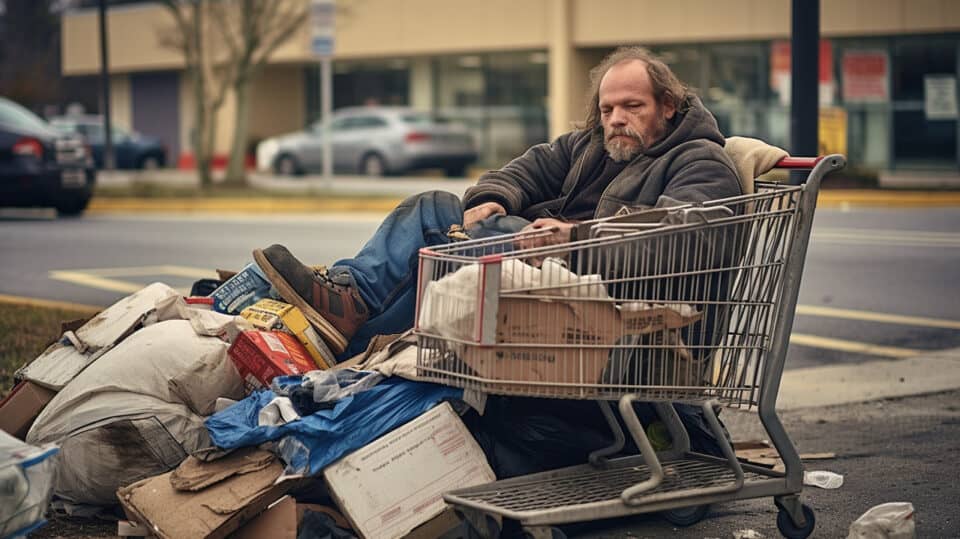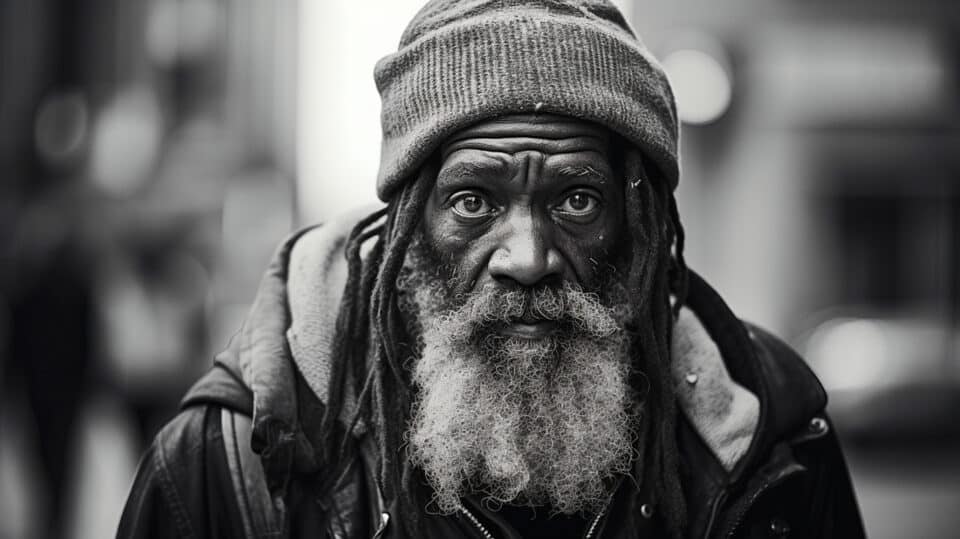Staring down the possibility of homelessness can be deeply unsettling. After all, it’s a reality that many unexpectedly find themselves on the brink of. I know – even I’ve had my own share of close calls in life.
It’s worth noting that over 47 million individuals in the US are living beneath the poverty line right now. So, if you’re finding yourself preparing for this unfortunate circumstance, don’t worry – we’re here to navigate these tough waters together.
This blog will guide you through essential steps to survive while holding onto your dignity during these trying times. Ready? Let’s face this challenge side by side and light our way forward!
Key Takeaways
Being homeless is hard, but you can make plans to face it.
Have a safe place to sleep, keep only essential things, stay clean, and have food and water.
Good clothes, shoes, and safety rules help in day-to-day life on the street.
Phones and mailboxes hold significant roles when living on the streets.
Table of Contents
Understanding Homelessness

Being homeless is tough. Many people in the US – over 47 million – are close to or live on the streets right now. This number keeps going up every year. Think about it as a big survival game show but without any gear, supplies, or option to leave.
Laws make it hard for those living on the streets, too, stopping them from setting up tents and other quick shelters in city areas. Homelessness can happen to anyone, no matter who they are or where they come from.
Essential Steps for Survival
When faced with homelessness, your first priority is to find shelter. Use resources like homeless shelters, or consider alternatives such as tent cities or bivy sacks. Next, streamline your belongings into practical items that can fit in an ALICE pack, urban commuter bag, or messenger bag. A compression sack can squish bulky clothes down to size.
Personal hygiene is crucial; gym memberships not only provide access to locker rooms and showers but also help maintain dignity. Wet naps, hand sanitizers, and high-SPF sunscreen are essential carry-ons.
Food storage strategies include carrying non-perishable foods like peanut butter and trail mix in cloth shopping bags while lightweight gear such as compact fishing rods offer additional food sources outdoors.
Stay hydrated – always have refillable water bottles handy, along with water purification tablets for safety measures.
In this digital age, maintaining an online presence helps you connect with opportunities that might improve life situations; websites like Amazon Mechanical Turk allow you to earn small amounts of money online, while job search sites provide employment openings. Make sure to utilize resources such as libraries, as they often offer free internet.
Finding Shelter
Living on the street is hard; people need a safe place to sleep. Many cities don’t allow homeless individuals to build temporary shelters or even sleep outdoors, resulting in a lack of available spaces.
Homeless shelters are one of the few places you can turn to; however, some of them are not safe due to the prevalence of drug use among those living there and people with mental issues, too. But it can be better than sleeping outside if you don’t have other options.
Streamlining Your Belongings
When preparing to be homeless, you’ll need a plan to make your things smaller. Here are the steps I follow:
- Go over what you own.
- Pick the most important items. Things like personal papers, identification, and Social Security cards have top spots.
- Clothes take up space – but you can’t do without them – so keep only what’s necessary.
- Toiletries also matter a lot! They must be small and light. Good examples here include wet naps and hand sanitizer.
- Food storage is tricky but can be done right with dehydrated foods and granola bars.
- An ALICE pack may come in handy for storing my belongings.
- Gym memberships are great! They offer storage options and a place to maintain hygiene.
- Regular check-ins on your stuff may also help you to throw out what’s not needed.
Maintaining Personal Hygiene
Staying clean is key when you’re on the street. You often can’t wash your clothes in a machine. Try shaking them hard to get rid of smells. Or use baking soda, baby powder, or carpet freshener as a stand-in for laundry soap.
Keep your shoes looking good by covering scuffs with markers or crayons. Be smart with every last bit of cosmetics you have. Only put time into basic care for your hair, and double duty any product that does more than one thing: lipstick can be blush and eyeshadow; chapstick helps rough skin on elbows and ankles.
These steps keep you feeling like yourself even when times are tough.
Securing Food and Water
Always make sure to have food and water to help you stay strong and healthy. I carry a cloth shopping bag full of foods like peanut butter, raisins, and granola bars. Dehydrated foods are light to carry, too.
When there’s no fresh water, I use water purification tablets or UV light to clean it. Fishing is good when near a river or lake. A compact rod and power bait become handy tools, then.
Accessing Internet/WiFi Services
Being on the streets does not mean no internet or WiFi. Nice airports, shopping centers, and college campuses offer good WiFi access. These places are safe, even during bad weather like storms.
The internet helps in many ways. You can use it to look for jobs on websites like Amazon Mechanical Turk, eBay, and Craigslist. You may also be able to find useful information on how to survive homelessness at libraries with free Internet/WiFi services.
To keep data safe while using public WiFi, it’s smart to use a VPN (Virtual Private Network). This way, your life stays private even when things get tough.
Securing Reliable Transportation
Having a way to get around is key. A good pair of shoes can make a big difference. Take care of your feet; they are your main form of travel. If you can, find a used bike. It’s faster and easier than walking.
Remember, not all who are homeless stay in one place. Sometimes, you have to move for food or a safe place to sleep. Be sure the bike is strong and works well if that’s the case.
Useful Tips for Surviving Homelessness

In surviving homelessness, every bit of knowledge can prove indispensable. Learn about managing your wardrobe for survival, keeping all items with you, maintaining warmth, and minimizing confrontations.
Also covered are navigating familiar terrain for safety reasons, carrying refillable bottles to stay hydrated, wisely selecting food options, and always having access to first aid essentials.
This section delivers practical strategies that will help you maintain life’s basic necessities while on the street or in shelters – read on to discover these key insights!
Dressing for Survival
Wear layers of clothing to keep warm. The bottom layer is the insulation layer – wear soft and warm things close to the skin there. On top of that, put a shell layer that can sheild you from wind or rain.
Besides keeping you dry, it also cuts down the wind chill effect, so you’ll feel warmer than you would otherwise! In cold weather, newspapers stuffed inside your clothes can give extra warmth, too.
Good shoes are like true friends in hard times, protecting your feet from all sorts of problems when walking for long hours on city streets and rough terrain.
Keeping Your Belongings with You Always
Keep your things close. Take them wherever you go. It’s hard, but it keeps them safe. You don’t want to lose important papers or personal items. These are essential documents, that, in a legal sense, are a part of who you are.
Don’t leave your bag alone anywhere! Sleep with it under your head if you can. That way, no one will steal from it while you sleep. Keep your cash well hidden, too, so people won’t find it easily.
Staying Warm

Staying warm is a big deal when living outside. In cold weather, it gets tough to keep your body heat. One good tool is the bivy sack. It’s like a waterproof bag you can zip up around yourself.
You use this for sleep, and it helps stop rain or snow from soaking your clothes. Safe places with warmth can be hard to find, too. Sometimes, bus stations, train stations, and airports are open all night long, and they might let you sit inside during bad storms.
Avoiding Conflict and Blending In
Being homeless can put you in tough spots. It’s smart to keep a low profile and avoid fights. Stay quiet, don’t draw attention or make noise. Stick to yourself, but be polite to others around you.
You need to blend in for your safety. Don’t argue or get into fights with people, as this will just cause problems for you. Oftentimes, police may not help if they see someone causing trouble who is also homeless.
So, it’s better for you if others don’t notice that you are living on the streets.
Sticking to Familiar Terrain
Stay in areas you know well. This will likely help you feel safer and more at ease. Your knowledge of the streets, shops, and people is your shield. Avoid dark alleys or shady spots where danger may lurk.
Sleeping in parks near lots of people also keeps you safe from harm’s way. With your tent set up in a hidden spot within the trees, you stay clear of issues with city laws, too. It’s not easy, but this way may work best for you right now.
Carrying Refillable Bottles for Hydration
Water is a must-have – carry refillable bottles at all times. It’s Important to drink enough water each day to stay healthy and strong. Make sure your bottles are light but tough so they won’t break easily or add weight to your bag.
It’s also smart to know where you can get clean, safe water. Parks, libraries, and other public places often have drinking fountains. Some stores also let people fill up their bottles for free in hot weather.
Using these spots saves money and keeps you hydrated throughout the day.
Choosing Your Foods Wisely
You need the right kind of food to stay healthy and strong. Go for foods that give you a lot of energy. These are often high in protein and fiber, like peanut butter, beef jerky, or granola bars.
Try to avoid foods that have too much sugar. They will make you feel good at first but then leave you tired later on. Always keep an eye out for fresh fruits and vegetables when they are available, as they provide valuable vitamins and minerals necessary for your body’s well-being.
Having Access to First Aid
Always keep a small first aid kit on your self. Band-aids, gauze, tape, antibacterial ointment, and pain relievers all become very important when living on the streets.
You might get cuts or scrapes from time to time. Being able to treat them right away stops them from getting worse. Having access to first aid can help you stay safe and healthy in tough times.
Navigating the System

Understanding how to navigate the system when homeless can be your lifeline. From setting up free phone services for connectivity to renting a PO Box for mail reception – every decision matters greatly.
Learn more about leveraging these resources in order to maintain communication and access crucial information while on this journey.
Utilizing Free Phone Services
Phones are important, helping you keep in touch with people. Free phone services can be a big help when you’re homeless. You can get one from groups like Lifeline. They give phones to people who don’t have much money.
Using the free phone is easy. You need to sign up and show that you don’t have a lot of money. Then, they will give you a phone for free or at a low cost. It can help you find work or talk to your family and friends.
Renting a PO Box for Mail
Renting a PO Box is a good idea for getting mail. You can rent it from the post office. It keeps your mail safe and in one place. This box comes with a key, so only you can open it.
You need to give the address of this box when you want to get letters or packages. It is not expensive to rent a PO Box, making it an affordable choice for people without homes.
Maintaining Hope and Resilience

Being homeless is tough, but, it is key to keep your head high and stay strong. You need hope to pull through trying times. Try thinking of the good things in life, even though it may seem hard right now.
You also need to be tough on the inside – we call this being resilient. This means not letting bad times bring you down for too long. Yes, there will be tough days when you feel like giving up, but remember, after every storm, there is calm.
So hang in there!
Frequently Asked Questions About Surviving Homelessness
What are some essential steps to survive being homeless?
Essential steps to survive being homeless include streamlining your belongings, staying clean with facial cleansing cloths and a collapsible pail, eating stored food like bagels and canned soups, dressing properly using gloves and socks, avoiding conflicts by staying in safe areas or abandoned buildings with cardboard insulation.
How can I maintain my appearance while being homeless?
Maintaining personal appearance includes using magnetic mirrors for grooming purposes such as shaving, ironing clothes if possible, managing menstrual hygiene using sanitary napkins or tampons, hair care with wet wipes, and keeping odors at bay by taking care of clothing care.
Are there any tools that can help manage homelessness better?
Tools like a bicycle, along with a Bob Yak trailer or child bicycle trailer, help in distributed living when you’re ready to leave one place for another. Personal items may be kept safe in safety deposit boxes.
Where should I seek help if I become homeless?
Help can be sought from federal programs such as the Homeless Assistance Program (HAP), local homelessness coalitions, and non-profit organizations like Goodwill, Salvation Army, and Catholic Charities, which provide transitional shelter assistance, among many other services.
Can maintaining good mental health help me while surviving on the streets?
Yes! Self-care, including stress management techniques, is crucial for good mental health, which keeps you substance-abuse-free, too. This also reduces the social stigma often attached to homelessness.
How do I manage my personal documents while being homeless?
Keeping your resume up-to-date is important even during hard times so it’s always ready for job applications. Store all personal information safely when prepping for SHTF scenarios or other situations.



